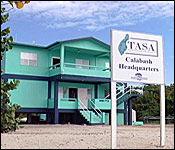
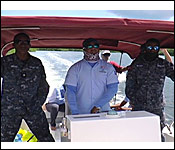 Last night, we showed you small snippet of our story on this weekend's trip that the Turneffe Atoll Sustainability Association organized for the press.
Last night, we showed you small snippet of our story on this weekend's trip that the Turneffe Atoll Sustainability Association organized for the press.
They are trying to show the general public what they do as co-managers of Turneffe Atoll Marine Reserve to try and preserve this marine protected area from overfishing and the pollution sometimes associated with cruise tourism.
It was a 2-day trip, and, today, we finally had time to fully unpack the event. Here's that full story now:
Daniel Ortiz reporting
On Friday morning, journalists from various media houses departed from the Princess Pier in Belize City, same as if they were reporting for a shift as one of TASA's rangers.
After the short journey by boat to the Reserve, the co-managers wasted no time, and launched into a briefing on the reasons for the trip, who they are, and what they do.
Valdemar Andrade - Executive Director, TASA
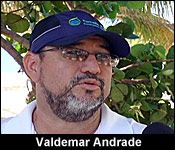 "The Turneffe Atoll Sustainability Association is basically an association made up of the stakeholders of Turneffe. And so, our membership is made up of fishers, which includes the Belize Federation of Fishers, the Belize Fishers Cooperative Association, the University of Belize who have a research station here, the private sector, the tourism industry, the Belize Tourism Board, the Fisheries Department, and we also have a person with natural resources background on the board as well. So, those are the members of TASA. Those people are the ones who make a decision on what management we implement here."
"The Turneffe Atoll Sustainability Association is basically an association made up of the stakeholders of Turneffe. And so, our membership is made up of fishers, which includes the Belize Federation of Fishers, the Belize Fishers Cooperative Association, the University of Belize who have a research station here, the private sector, the tourism industry, the Belize Tourism Board, the Fisheries Department, and we also have a person with natural resources background on the board as well. So, those are the members of TASA. Those people are the ones who make a decision on what management we implement here."
"Turneffe is the largest Marine Reserve in Belize. We're talking about a reserve that's 30 miles long and 10 miles wide, and so, our main mandate is the conserve Turneffe."
"85% of the area you can fish, under certain regulations. We have certain conservation zones, which you can only fish certain species. We have some complete no-take zones, which includes a manatee preservation area."
So, to best utilize their financial resources for enforcement activities, TASA has set up 3 strategic locations within the Turneffe Atoll, which provides quick response capabilities.
Valdemar Andrade
"We have 3 conservation posts at key locations where the pressure points are for the reserve. We have one at Mauger Caye, which is at the far north of Turneffe, where we have a conch conservation site, and also a spawning aggregation site. We have this central here at Calabash, which is a central area we can deploy both north and south to be able to cover the entire reserve And, we have one at Caye Bokel, which is way at the south at the Caye Bokel Conservation point, which is also a pressure point for us. That's also a spawning aggregation site, a multi species fin-fish spawning aggregation site."
TASA says that they work closely with the Coast Guard and the Fisheries Department to police the reserve against illegal and harmful fishing practices.
Valdemar Andrade
"The difference Between marine protected areas and terrestrial protected areas is that under the Fisheries Act, our officers are official fisheries officers. The Minister gives them that ability. So, we send a list to fisheries. Fisheries sends that list up to the Ministry. The Minister basically passes that official rights on to them. So, they are able to warn, issue summons, prosecute and build case files, and then Fisheries prosecutes on our behalf."
"Both of us, Fisheries and TASA sit on the Maritime Security Committee, because out here, it's not only about fishing. You all know that other activities happen out here as well. I can tell you that Coast Guard is on about 75% of our patrols. So, if you'll see, most of the pictures you see of us on patrol, you will see a Coast Guard [officer] because we don't carry weapons, but they do, the same thing with fisheries. Fisheries also carries weapons."
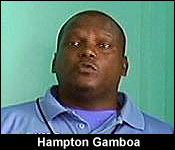 Hampton Gamboa - Fisheries Compliance Officer
Hampton Gamboa - Fisheries Compliance Officer
"Enforcement itself is a team effort. It's something that you try to do a lot of joint operations, and collaborations with other agencies. Because, as police would always tell you, enforcement is expensive. And of course, we being the government entity, we basically are running on fumes."
Lt. Junior Grade Noe Hernandez - Commander, Calabash Observation Post
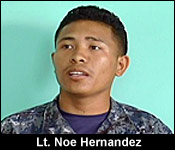 "Our primary role is to do search and rescue, and also that military roll. But also, one of our objectives is to work with our NGO's, our partner neighbors."
"Our primary role is to do search and rescue, and also that military roll. But also, one of our objectives is to work with our NGO's, our partner neighbors."
"We conduct constant patrols with them, not only to provide security, but also to enforce, 1., fisheries regulations, 2., to deter any illegal activities, and to conduct proper board and search on any suspected vessel in the EOR."
Valdemar Andrade - Executive Director, TASA
"Out here, you have to work in true partnership to survive."
So, how do the TASA rangers work to reduce illegal activities at Turneffe? Well, they conduct joint boat patrols, informed by intelligence on where the highest level of illegal activities are take place.
Valdemar Andrade
"The main thing is sustainability. You look at our fuel cost. We're probably spending around $75,000 a year in fuel, to do 25.5 patrols days for the month."
To reduce their operational costs, TASA rangers employ technology that has become standard in the conservation community. They fly drones for reconnaissance, and they use the Spatial Management and Reporting Tool or SMART technologies in the field to record all their enforcement information for every search that they conduct on fishermen they encounter inside the reserve.
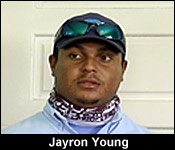 Jayron Young - Chief Conservation Officer, TASA
Jayron Young - Chief Conservation Officer, TASA
"The system works in 2 ways. You have an app that collects the information. It's usually via a device. We have CT5's that we use to collect these information. The information is collected on an app called cyber tracker. It has forms that collect information on the vessel being used, the team going out, the time, any patrols of port, any information we collect in terms of fishers encountered, their license, what product they had, what was the state of the product, where we found them."
"Whenever we get through with the day, we bring the devices back. We download the data to the laptop, into the SMART sim, which is the actual system that manages the data."
The data is almost real-time in that, it runs on a server that is hosted outside of Belize. So, whenever we come back, we synchronize that. The information goes up to the server. Whatever device has that SMART System, as soon as they synchronize, that information is available to everyone right away.
Valdemar Andrade
"With that, we know how much hours each officer spends on the water, how many patrols they do for the month, because that's also a deliverable on their job description. We know how many arrests they have made, how many case files they've created, and we also know where they are collecting data."
But, for TASA, it's not always about being the stern, no-nonsense guardians of the Turneffe Atoll. They also engage in public education campaigns in the hopes that the fisher-folk they encounter in the marine reserve will not need to be prosecuted because they are following the rules:
Valdemar Andrade
"The other challenges are the pressures from the fishers that use the area, the people who do illegal activities, because they actually off-set what fishers who are doing legal activities do. And so, we have to look at how do we educate those - and also, in some cases, how do we ween out people who are doing these practices over and over again."
"Our main users are Chunox, Copperbank, Sarteneja, and so they are communities that are not close to Turneffe. So, we have to go and do outreach in those communities. We also employ boat to boat, where we go and share information with them boat to boat."
Of note is that while TASA, Coast Guard, and Fisheries were out on joint patrol with the press, they encountered 2 minors who were engaging in illegal fishing practices in the marine reserve. Those persons will now be facing charges, and their parents will have to show up with them to court to answer to the offenses.



